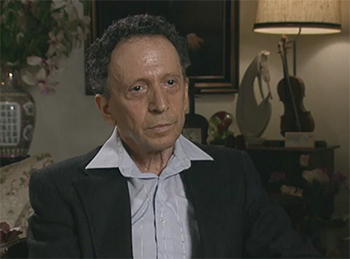
Shony Braun
Watch Shony Braun’s full testimony from the Visual History Archive as part of Comcast’s Days of Remembrance: PastFORWARD broadcast April 15-June 1, 2015.
In the forests of Romania in 1934, four-year-old Shony Braun was out for a walk with his babysitter when he wandered off and became lost. A gypsy woman, hearing his cries and not knowing who he was or where he belonged, took him to the gypsy camp for safety. Upon their arrival, Shony’s attention was utterly transfixed by something: a violin. It was the most beautiful sound he had ever heard.
After three days with the kind gypsies, listening to their music, he was reunited with his family. The first words out of his mouth were, “I want this,” while pantomiming playing a violin – he didn’t even know the word for it yet. A year later, when his parents were sure he was serious about it, he began taking lessons – never knowing that his talent would one day save his life.
Though the Brauns – Shony’s father, a jewelry designer, mother and five siblings – were well-liked in their small town in Romania, they were one of only a few Jewish families. When World War II began, they were forced to wear yellow armbands, were subjected to restrictions such as curfews, and their Christian friends turned against them. In 1944, when Shony was 13, the family was deported to Auschwitz.
Josef Mengele immediately selected Shony’s mother and younger sister for death in the gas chamber (ironically, Shony remembers him gesturing with a conductor’s baton). When it was his turn, Shony told Mengele he was 16. Suspicious, Mengele allowed him to live but assigned Shony to work as a sonderkommando, transporting victims of the gas chamber to the crematoria. Shony would have nightmares about this hellish job for the rest of his life.
A few months later, Shony was sent to the Natzweiler camp system in France – the same day his fellow sonderkommandos were murdered at Auschwitz. In France, though he was forced to work for the German war effort, conditions were better, and again he was miraculously spared from death even after he was caught participating in a sabotage plot.
From there, Shony was sent to Dachau. One day, an SS officer came to his barrack and held up a violin. Anyone who could play was to come with him to demonstrate his skills, and whoever played the best would get food and water. Shony and two others jumped at the chance, but they found a cruel game waiting for them. The first man to play was a virtuoso, Shony recalls, who played more beautifully than anyone he’d ever heard, but the SS directed a kapo to smash his head with a lead pipe. The next man was beaten to death when he was too nervous to play.
Finally it was Shony’s turn. He picked up the violin and realized he couldn’t remember a single song. He began praying, preparing himself for death, as the kapo came closer, ready to strike him with the lead pipe. Suddenly, inexplicably, Shony lifted the violin and began to play “The Blue Danube Waltz” by Johann Strauss II – for the first time in his life. He had never played the song before. Yet it was the best he’d ever performed – strong, confident, flawless. It was truly a miracle, Shony says.
“God’s hands were on my violin,” he says. “There’s no other way.”
From then on, Shony was a favorite of the SS, who would often make him perform for them, give him food, and then have their own fun, firing their revolvers dangerously close to his head. The day before American soldiers liberated the camp, he was shot in the chest, but thanks to a French prisoner who had taken Shony under his wing, he survived.
Shony met his future wife, Shani, at the DP camp in Germany where he was recovering, and the two ended up in Cleveland, Ohio. They stayed for eight years and then moved to Los Angeles, where Shony managed a textile factory and became a professional violinist and composer. His Symphony of the Holocaust was nominated for a Pulitzer Prize.
When he gave his testimony to the Visual History Archive in 1994, Shony had two children and two grandchildren. He died in 2002 at 72 years old.
“It’s up to us how we want to live and how we want others to live,” Shony says at the end of his testimony. “If you want to make a beautiful world or a terrible world, it’s up to us.”